The Samsung SSD 840 is an entry-level consumer SSD and is the first to be made with TLC (Triple Level Cell) NAND. This differs from the MLC (Multi Level Cell) NAND used in every other consumer SSD. Up to this point, TLC NAND has only been used in less critical applications like USB thumb drives and memory cards, but its acceptance in the SSD space is emerging in large part because of the reduced cost of the NAND packages. Of course the tradeoff for the lowered price-point is endurance, but as consumers are coming to accept, most of them really don’t write all that much data to their drives. The Samsung SSD 840 is built off of the same platform as the Samsung SSD 840 Pro with the Samsung MDX triple-core ARM 9 controller which is clocked at 300MHz and leverages Samsung’s NAND and proprietary firmware.
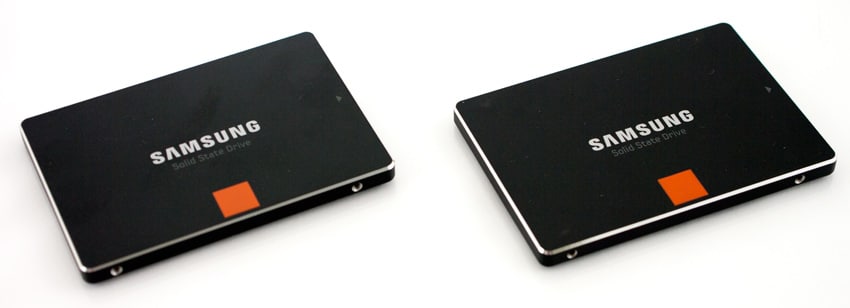
Samsung is the first to market with a TLC-based drive, but the concept is not new. SSD vendors have always strived to drive cost out of their builds, with the common thought being that lower priced SSDs will drive adoption. It’s the consumer though that’s been the stumbling block to TLC adoption. Sure, it would be easier to say the NAND has been the problem; TLC has much less endurance, higher failure rates and is generally less compliant than its MLC sibling. SSD vendors have been reticent to release TLC drives however because of a fear that consumers wouldn’t view the platform as reliable and capable enough. The truth though is that for the mainstream compute market, consumers write very little data. Sure, they stream a lot of content and answer a good deal of email, but those don’t hit the SSD where it hurts, data writes. TLC has also been plagued by reliability concerns, but Samsung figures they’ve engineered a way around these concerns with the SSD 840.
As with the SSD 840 Pro and prior consumer SSD iterations, Samsung is continuing to design and manufacture all key components. With its NAND flash, drive controllers, DRAM and software all developed under the same roof, Samsung is well positioned to deliver a quality product. An all-Samsung drive means that the company is both positioned to achieve the best performance from individual components and that Samsung can respond more quickly with firmware updates to any problems the SSD 840 may encounter. This peace of mind, especially with a major piece of unproven technology like TLC NAND, gives Samsung a decent chance of commercial success if the price difference between the Samsung 840 and the competition is significant.
The Samsung SSD 840 is available in 120GB, 250GB and 500GB capacities which are slightly lower than the Samsung SSD 840 Pro due to over provisioning difference. Where users benefit by switching over to TLC NAND is in drive economics. The 120GB version of the Samsung SSD 840 can be found for a street price around $110, which is just 73% of the cost of the $150 street price 128GB SSD 840 Pro. The 250GB version can be found with even greater savings over its sibling at a street price around $150, 63% of the $240 the 256GB SSD 840 Pro costs. The 500GB version of the Samsung SSD 840 can be found for a street price around $370, 71% of the $520 512GB SSD 840 Pro pricing. Our review drives are 250GB and 500GB models.
Samsung SSD 840 Specifications
- Capacities: 120GB, 250GB, 500GB
- Form Factor: 2.5-inch, 7mm
- Interface: Serial ATA 3.0, up to 6Gb/sec
- Controller: 3-core MDX controller (300MHz)
- Performance
- 120GB (MZ-7TD120BW)
- Sequential READ: up to 530 MB/s
- Sequential 128KB WRITE: up to 130 MB/s
- Random READ: up to 85,000 IOPS
- Random WRITE: up to 32,000 IOPS
- 250GB (MZ-7TD250BW)
- Sequential READ: up to 530 MB/s
- Sequential WRITE: up to 240 MB/s
- Random READ: up to 95,000 IOPS
- Random WRITE: up to 44,000 IOPS
- 500GB (MZ-7TD500BW)
- Sequential READ: up to 500 MB/s
- Sequential WRITE: up to 330 MB/s
- Random READ: up to 97,000 IOPS
- Random WRITE: up to 63,000 IOPS
- 120GB (MZ-7TD120BW)
- Mechanical
- Power Consumption: 0.15W
- SATA connector: 5V ±5%
- Dimensions (H x W x D): 0.28 by 2.75 by 3.94 in
- Weight: 0.15lb
- Operating temperature: Commercial (32°F to +140°F)
- Warranty: Three (3) years
Design and Build
The Samsung SSD 840 shares the same overall appearance as the Samsung SDD 840 Pro. The SSD features a sturdy build with a metal top and bottom cover. Samsung also designed the 840-series to fit a range of applications including desktops, notebooks, and ultrabooks by using a 7mm Z-height.
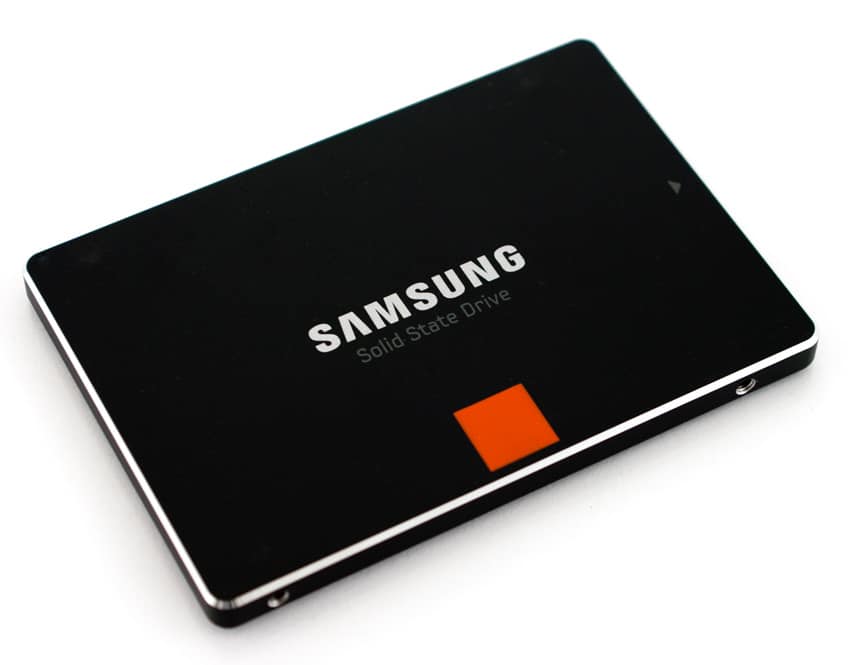
The only visual difference between the 840 and 840 Pro is the drive specific information on the label affixed to the bottom of the drive.
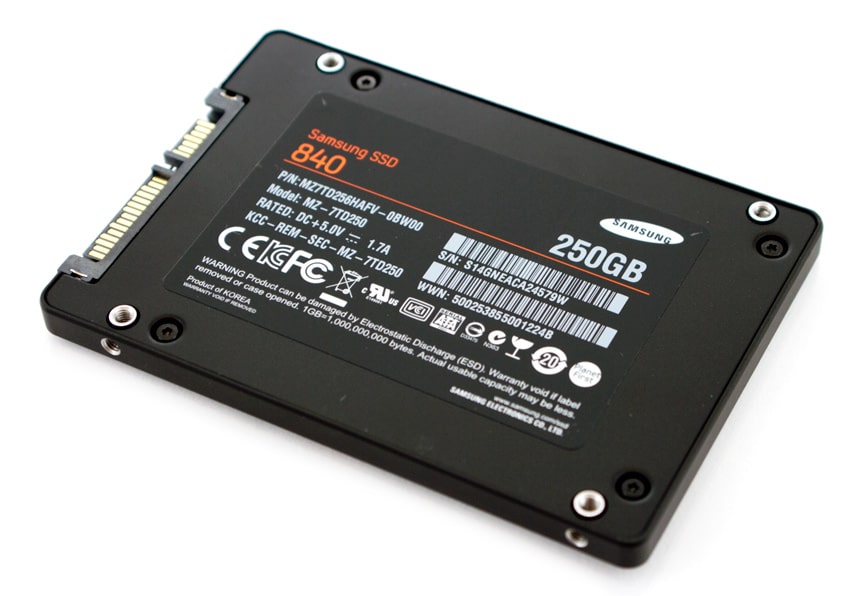
Disassembly
The Samsung SSD 840 is identical (besides NAND) to the Samsung SSD 840 Pro, which can be simply disassembled by removing four screws.
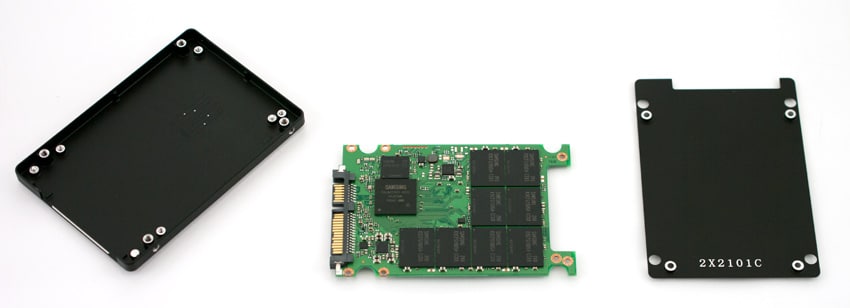
The SSD 840 uses the same Samsung MDX S4LN021X01-8030 controller as the SSD 840 Pro, but with TLC NAND from eight 32GB packages (in the 250GB SSD 840). The board also includes 512MB of DRAM for cache with a Samsung K4P4G324EB-FGC2 module.
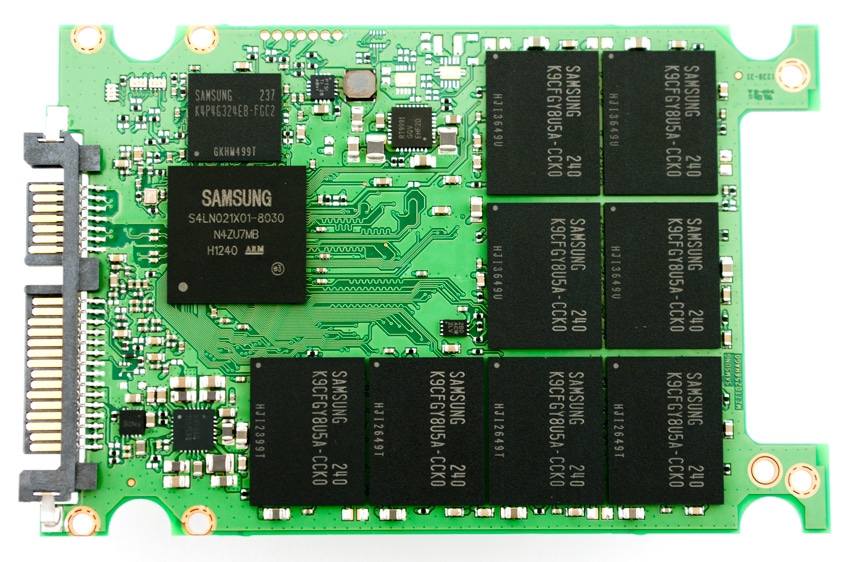
Consumer Synthetic Benchmarks
All consumer SSD benchmarks are conducted with the StorageReview Consumer Testing Platform. The comparables used for this review include:
- SanDisk Ultra Plus (256GB, Marvell 88SS9175, SanDisk 19nm eX2 ABL MLC NAND, SATA)
- SanDisk Extreme SSD (240GB, SandForce SF-2281, SanDisk 24nm MLC Toggle NAND, SATA)
- Samsung SSD 840 Pro (512GB, 300mhz Samsung 3-core MCX controller, Samsung 2x nm Toggle NAND Flash, SATA)
- Plextor PX-M5S (256GB, Marvell 9174, Micron 25nm MLC NAND, SATA)
- OCZ Vector (256GB, Indilinx IDX500M00-BC Barefoot 3, 25nm MLC NAND, SATA)
All IOMeter figures are represented as binary figures for MB/s speeds.
In our first test measuring 2MB sequential performance, the 250GB Samsung SSD 840 measured 551.80MB/s read and 247.99MB/s write, while the 500GB Samsung SSD 840 measured 506.04MB/s read and 315.29MB/s write. The Samsung SSD 840 equals the read performance of the 512GB Samsung SSD 840 Pro, however its write performances falls behind most of the drives.
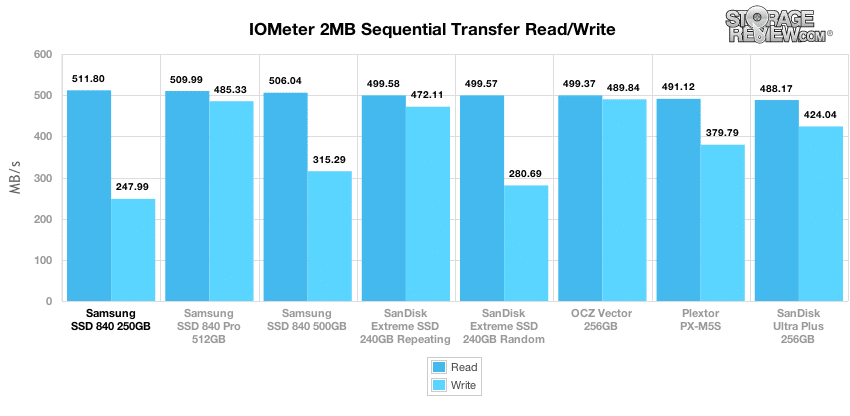
In our next test looking at 2MB random transfer performance, the 250GB Samsung SSD 840 measured 489.55MB/s read and 279.24MB/s write, while the 500GB Samsung SSD 840 measured 4879.07MB/s read and 303.30MB/s write.
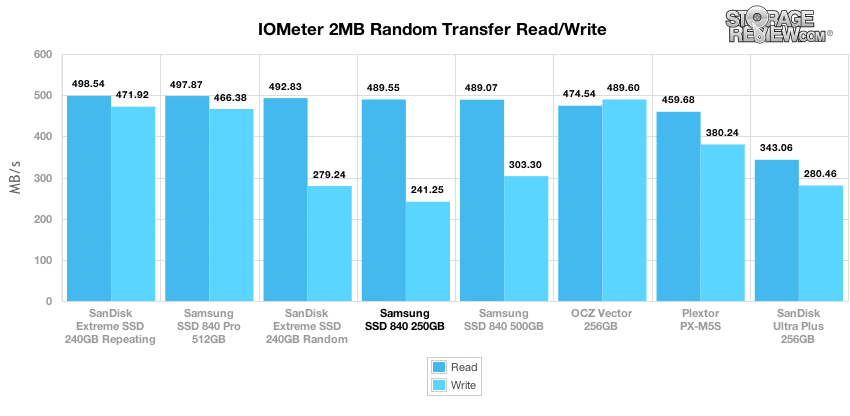
Switching to smaller 4k random transfers, the 250GB Samsung SSD 840 measured 6983.05 IOPS, while the 500GB Samsung SSD 840 measured 171.89 IOPS read at QD1. Write speeds measured 18144.02 IOPS (250GB) and 18105.67 IOPS (500GB). Both drives ranked towards the lower middle of the pack in read and write performance.
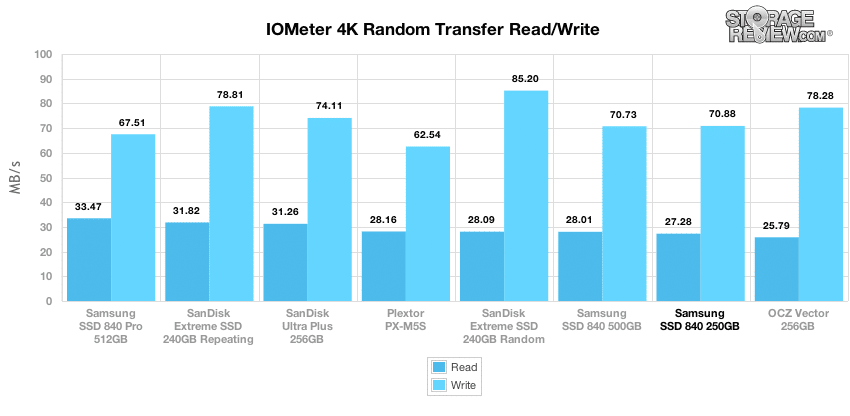
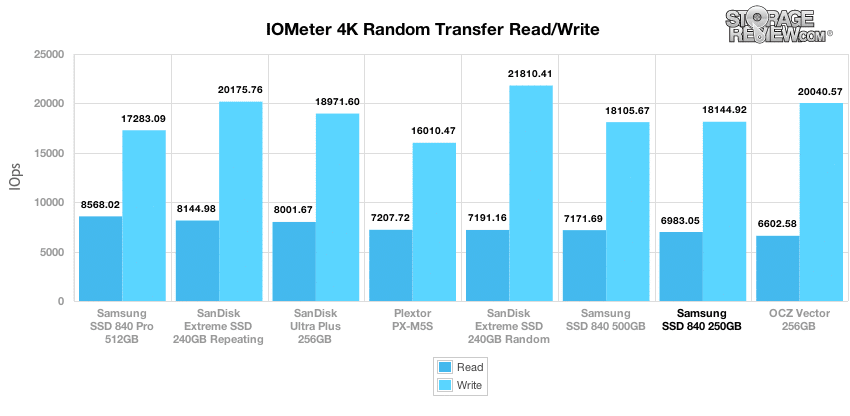
In our next test, we shift to a smaller 4k random workload with 100% read activity that scales from 1QD to 64QD. In this setting, the 250GB Samsung SSD 840 measured from 6910.83 IOPS up to nearly 96,000 IOPS. The 500GB Samsung SSD 840 measured 7208.44 IOPS up to nearly 98,000 IOPS.
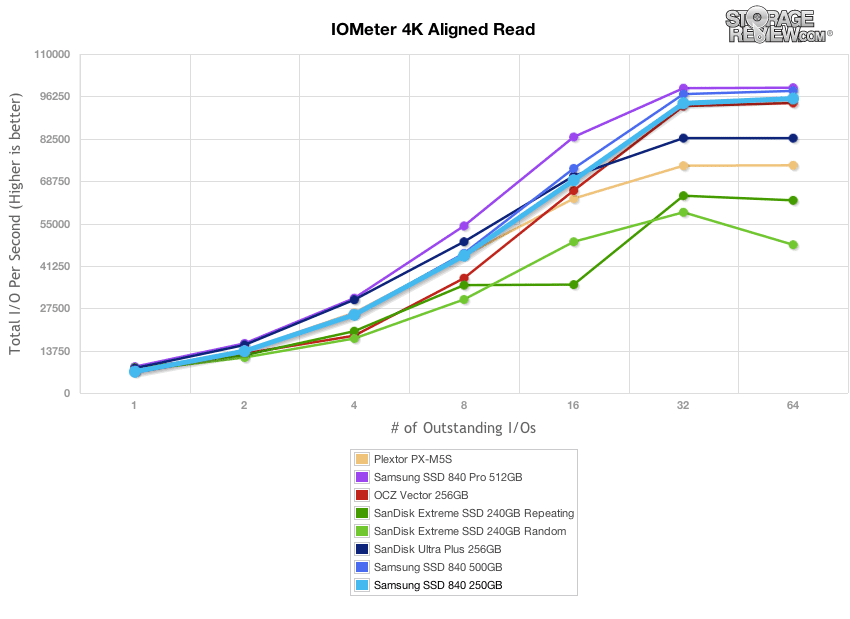
Shifting focus to write activity, the Samsung SSD 840 performed higher than SanDisk’s SSDs, and overall they ranked toward the middle of the pack. The 250GB measured 18632.21 IOPS at QD1 and peaked at just under 60,000 IOPS at QD32. The 500GB model measured 18291.34 IOPS and peaked at just over 64,000 IOPS at QD32.
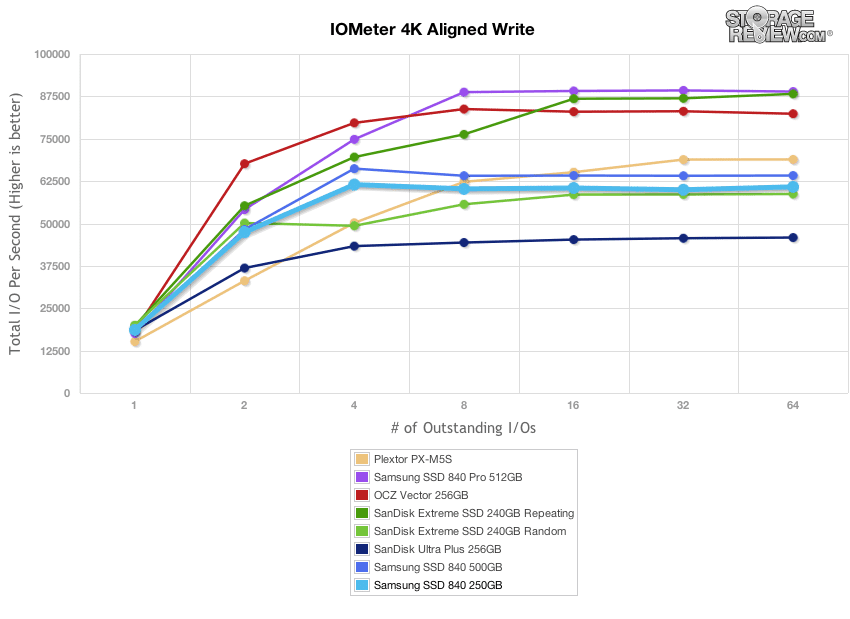
Comparing average write latency between each mainstream consumer SSD, the Samsung SSD 840 ranked in the middle of the group. The 250GB Samsung SSD 840 had a time of 0.0546ms and an ultra-low peak latency of 2.01ms. The 500GB Samsung SSD 840 had a time of 0.0547ms and a very low peak latency of 3.70ms.
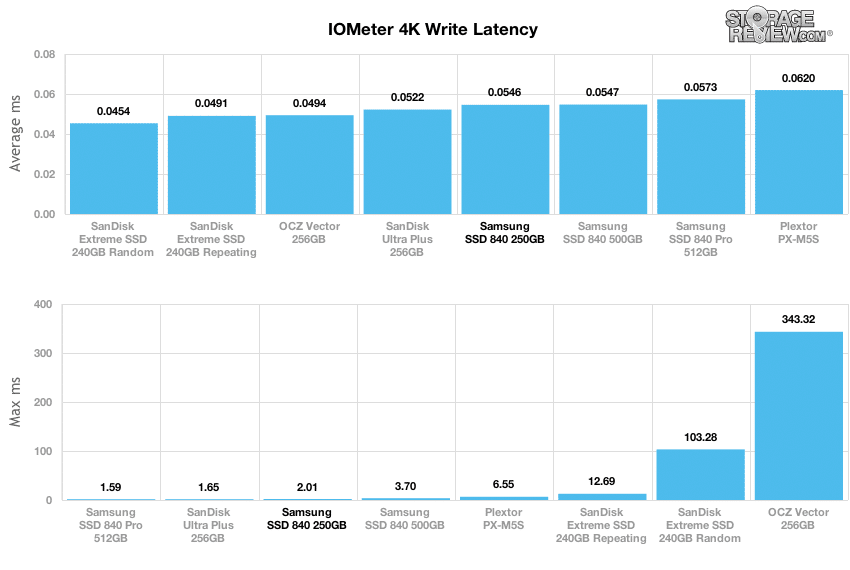
Our last series of synthetic benchmarks compare the hard drives in a series of server mixed-workloads with a queue depth of ranging from 1 to 128. Each of our server profile tests has a strong preference towards read activity, ranging from 67% read with our database profile to 100% read in our web server profile. In all of our mixed workloads the Samsung SSD 840 ranked at the bottom of the pack except the Web Server profile where the 840 and 840 Pro drives were highly successful.
The first is our database profile; with a 67% read and 33% write workload mix primarily centered on 8K transfer sizes.
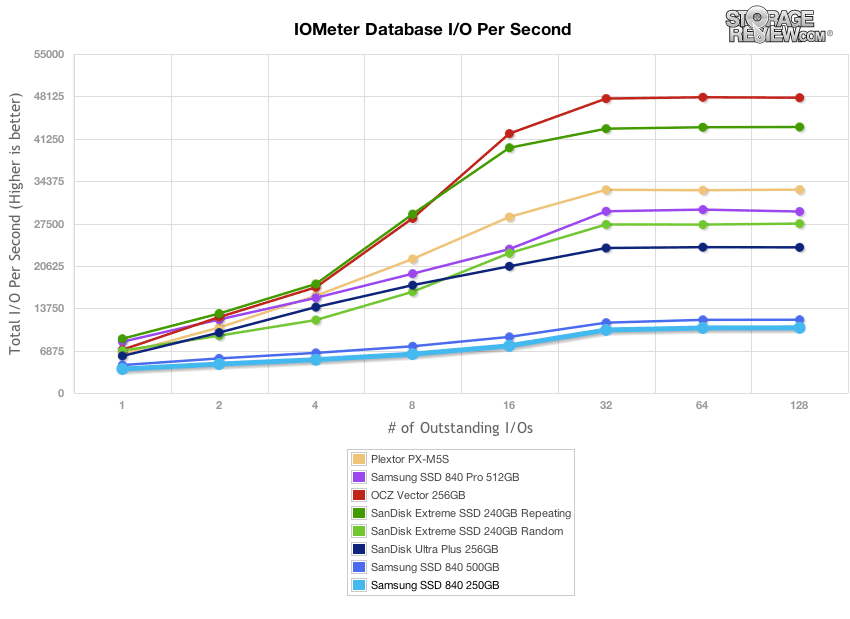
The next profile looks at a file server, with 80% read and 20% write workload spread out over multiple transfer sizes ranging from 512-byte to 64KB.
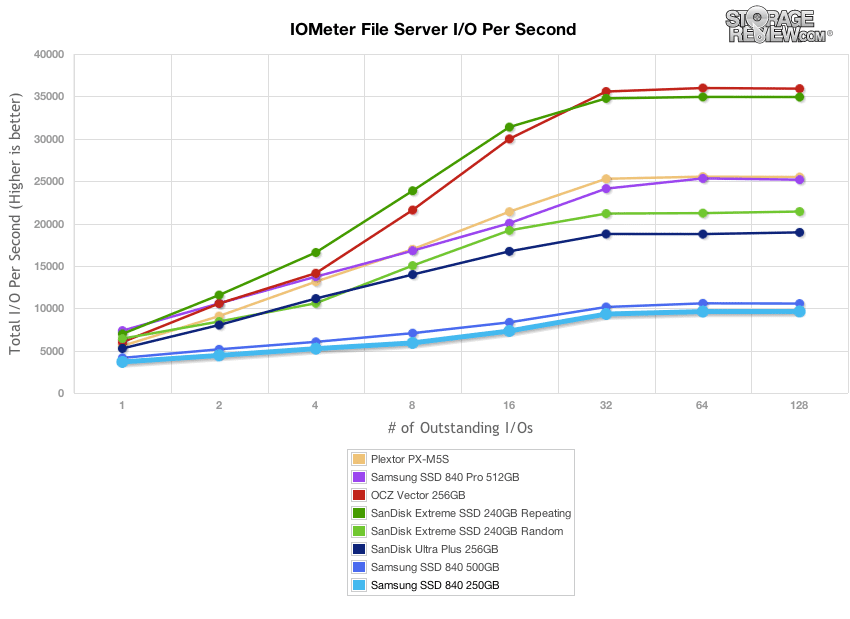
Our web server profile is read-only with a spread of transfer sizes from 512-byte to 512KB.
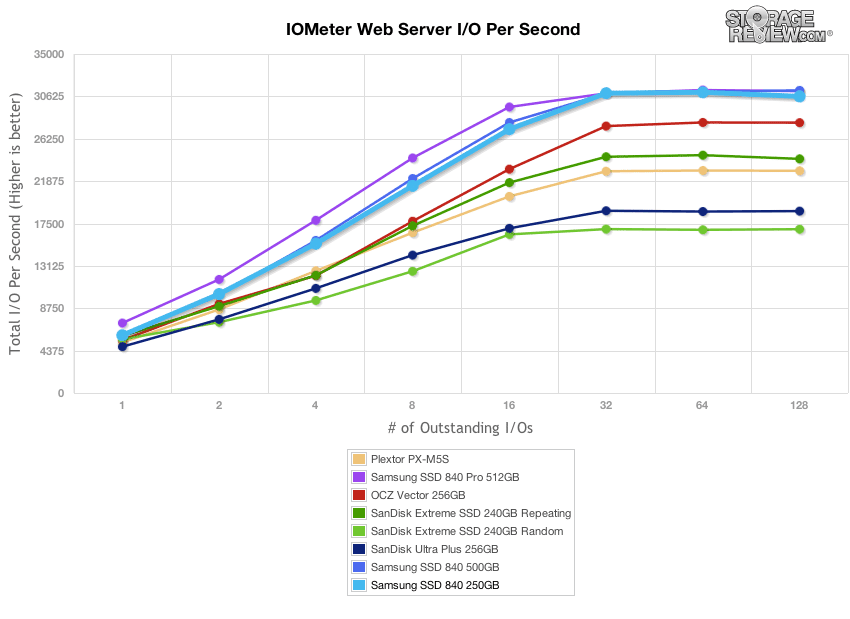
The last profile looks at workstation activity, with a 20% write and 80% read mixture using 8K transfers.
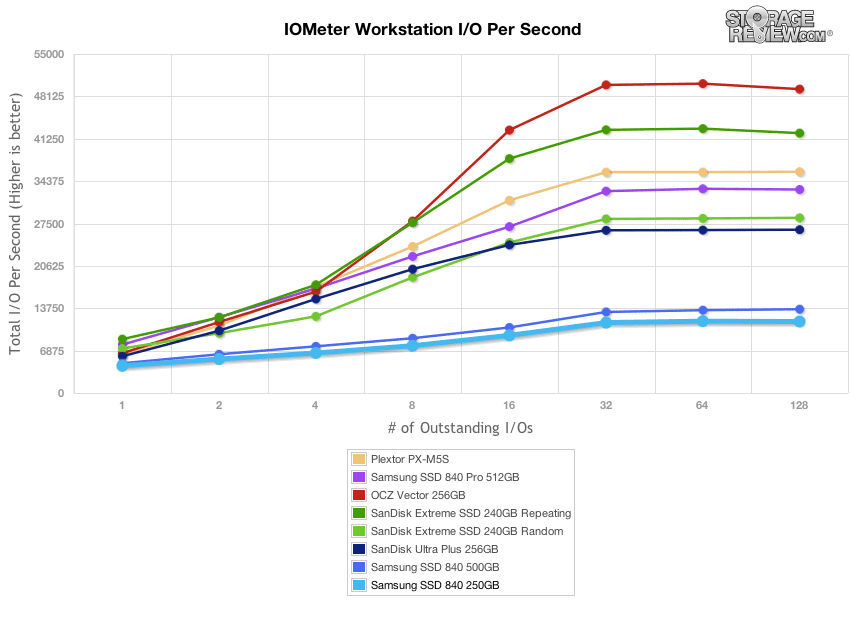
Consumer Real-World Benchmarks
For the average consumer, trying to translate random 4K write speeds into an everyday situation is pretty difficult. It helps when comparing drives in every setting possible, but it doesn’t exactly work out into faster everyday usage or better game loading times. For this reason we turned to our StorageMark 2010 traces, which include HTPC, Productivity, and Gaming traces to help readers find out how a drive might rank under their conditions.
The first real-life test is our HTPC scenario. In this test we include: playing one 720P HD movie in Media Player Classic, one 480P SD movie playing in VLC, three movies downloading simultaneously through iTunes, and one 1080i HDTV stream being recorded through Windows Media Center over a 15 minute period. Higher IOps and MB/s rates with lower latency times are preferred. In this trace we recorded 2,986MB being written to the drive and 1,924MB being read.
In our HTPC profile, the 250GB Samsung SSD 840 fell below the other competing consumer SSDs with an average speed of 173.67MB/s. The 500GB Samsung SSD 840 didn’t perform much better, but it did beat out the SanDisk Ultra Plus 256GB with an average speed of 195.09MB/s.
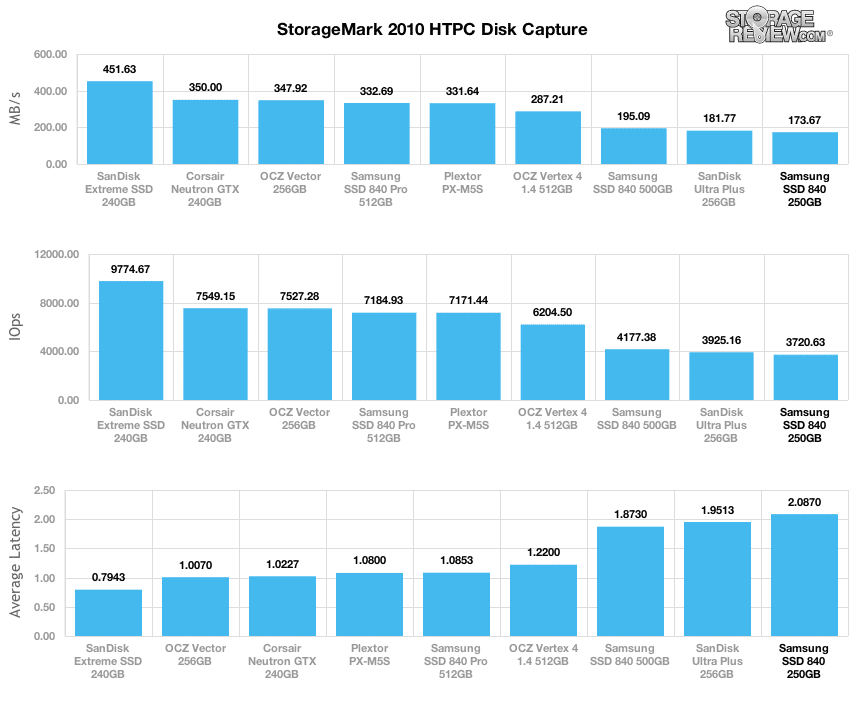
Our second real-life test covers disk activity in a productivity scenario. For all intents and purposes this test shows drive performance under normal daily activity for most users. This test includes: a three hour period operating in an office productivity environment with 32-bit Vista running Outlook 2007 connected to an Exchange server, web browsing using Chrome and IE8, editing files within Office 2007, viewing PDFs in Adobe Reader, and an hour of local music playback with two hours of additional online music via Pandora. In this trace we recorded 4,830MB being written to the drive and 2,758MB being read.
In our Productivity trace, the Samsung SSD 840 drives were at the back of the group of consumer SSDs with the 250GB averaging 144.17MB/s. The 500GB performed with an average speed of 147.64MB/s.
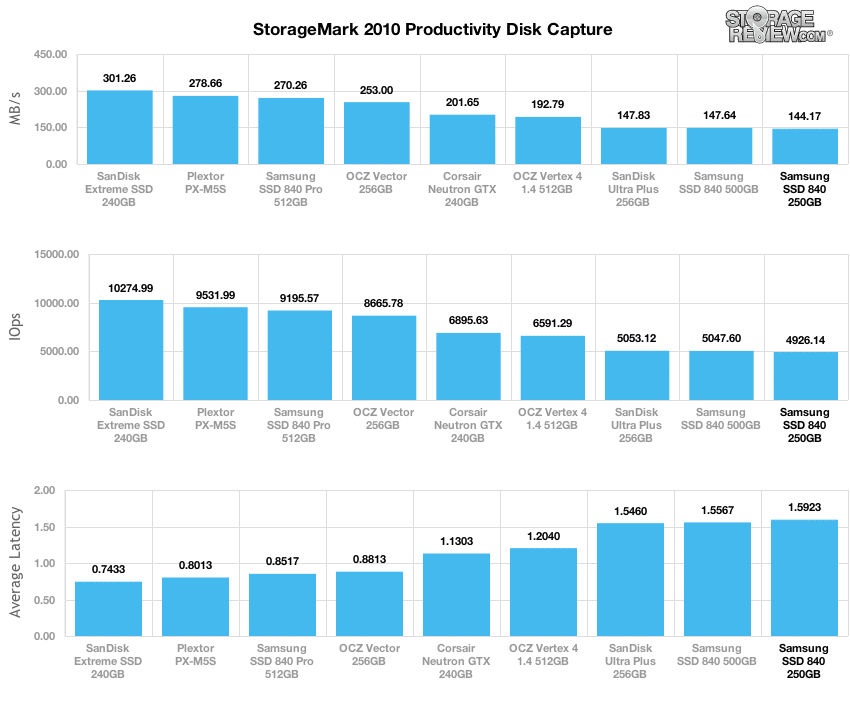
Our third real-life test covers disk activity in a gaming environment. Unlike the HTPC or Productivity trace, this one relies heavily on the read performance of a drive. To give a simple breakdown of read/write percentages, the HTPC test is 64% write, 36% read, the Productivity test is 59% write and 41% read, while the gaming trace is 6% write and 94% read. The test consists of a Windows 7 Ultimate 64-bit system pre-configured with Steam, with Grand Theft Auto 4, Left 4 Dead 2, and Mass Effect 2 already downloaded and installed. The trace captures the heavy read activity of each game loading from the start, as well as textures as the game progresses. In this trace we recorded 426MB being written to the drive and 7,235MB being read.
In our read-intensive Gaming trace, the Samsung SSD 840 drive came in ahead of the SanDisk Ultra Plus 256GB and OCZ Vertex 4 1.4 512GB. The 250GB Samsung SSD 840 had an average speed of 434.47MB/s, with the 500GB’s average speed at 433.74MB/s.
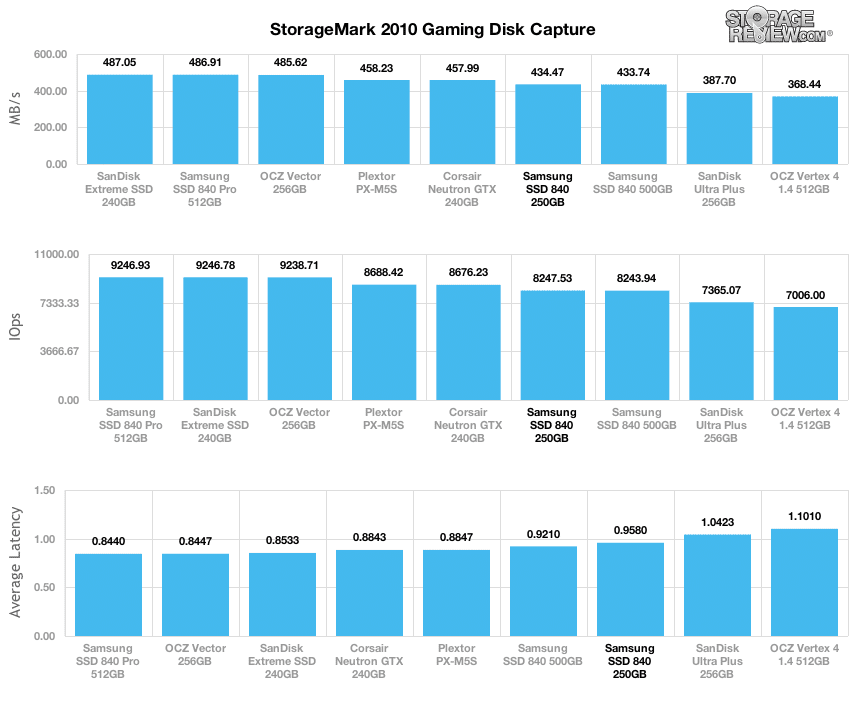
Power Consumption
As SSDs spend much of their time in the idle state, low idle power consumption is a key factor in overall SSD power management. The Samsung 840 is stated as having a typical power consumption of 150mW.

In our tests we measured idle power consumption from the Samsung SSD 840 250GB at 0.29 watts, with the highest overall total at 3.85 watts during sequential write activity. With the Samsung SSD 840 500GB, we noted similar idle power at 0.30 watts, but power crept up a bit more to 4.97 watts during sequential write activity.
Conclusion
The Samsung SSD 840 is the first consumer SSD to be manufactured with TLC NAND in order to continue driving SSD prices closer to hybrid hard drive offerings. This is a huge step forward in making SSDs more competitive in the market as many consumers are budget-conscious, especially given the capacity advantages they find in HDDs. The Samsung SSD 840 also continues to feature in-house designed components to make it easier for Samsung to optimize performance and offer firmware updates.
In our synthetic benchmarks, the SSD 840 matches and at times even exceeds the read performance of the SSD 840 Pro in 2MB random and sequential testing. However, when it came to write performance there was a significant drop off compared to the MLC-based consumer SSDs we tested. As we moved to 4k random and sequential read performance, the SSD 840 began to fall behind the SSD 840 Pro and the other consumer SSDs tested in read performance, but was able to remain competitive in write performance. In the real world traces the drive stumbled again, coming in last twice and near the back in the third.
The tangible upside of the Samsung SSD 840’s utilization of TLC NAND is the significant decrease in price per GB. The Samsung SSD 840 offers the lowest price in the mainstream consumer SSD category. The performance is also good enough, despite the poor showing in the real world traces, that anyone coming from a hard drive or even a hybrid hard drive will see excellent performance gains. If you’ve been with SSDs for a while though, the SSD 840 won’t hold a candle to the latest high-end SSDs, though SSD veterans are unlikely to be considering this drive for purchase anyway. The SSD 840 is really designed to be a gateway product, ushering in low prices in mainstream or even value builds where the consumer can leverage the benefits of flash technology.
Lastly, it must be said that with TLC we know comes lower drive write endurance. It’s hard to envision many consumers running out of write capability with their SSD 840, but there will surely be some who do. That day will probably come after the warranty has expired though, which is short at just three years. The warranty is longer than hard drives however, which have dwindled down to one or two years in many cases. The good news is that Samsung has the infrastructure to support the drive; with their name on it consumers can feel better about taking a chance on TLC.
Pros
- Affordable TLC NAND
- Low price per gigabyte
- Great 4k random read and web server profile performance
Cons
- Overall weak write performance
- Weak overall performance in our consumer real-world benchmarks
Bottom Line
The Samsung SSD 840 brings the utilization of TLC NAND to the SSD market, which provides a decrease in price that makes SSDs more affordable for the mainstream audience.
Samsung SSD 840 at Amazon.com



 Amazon
Amazon